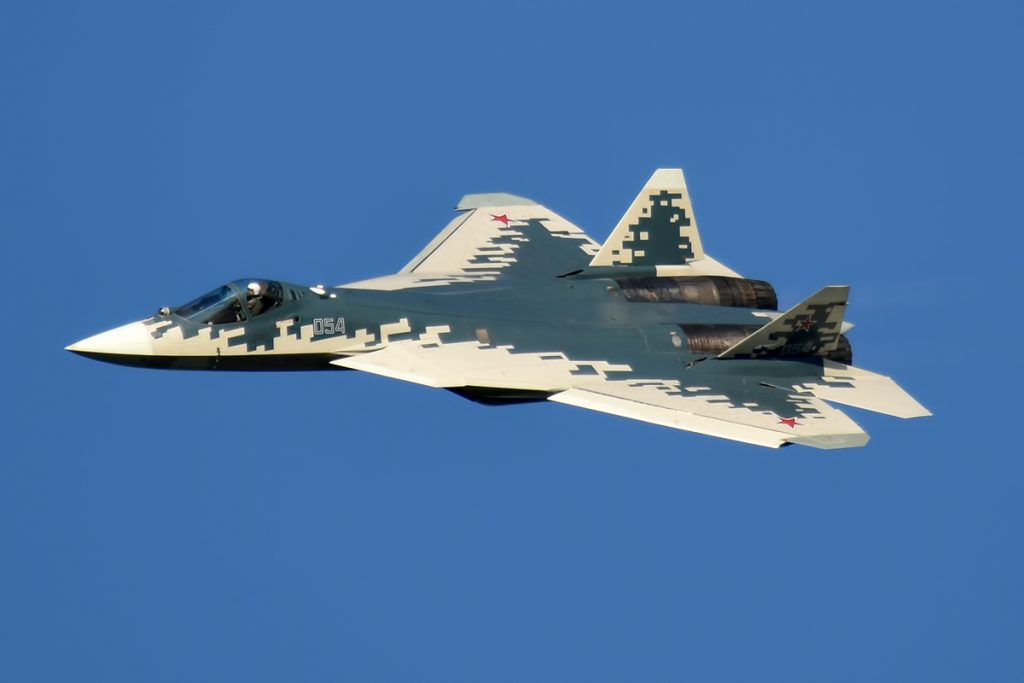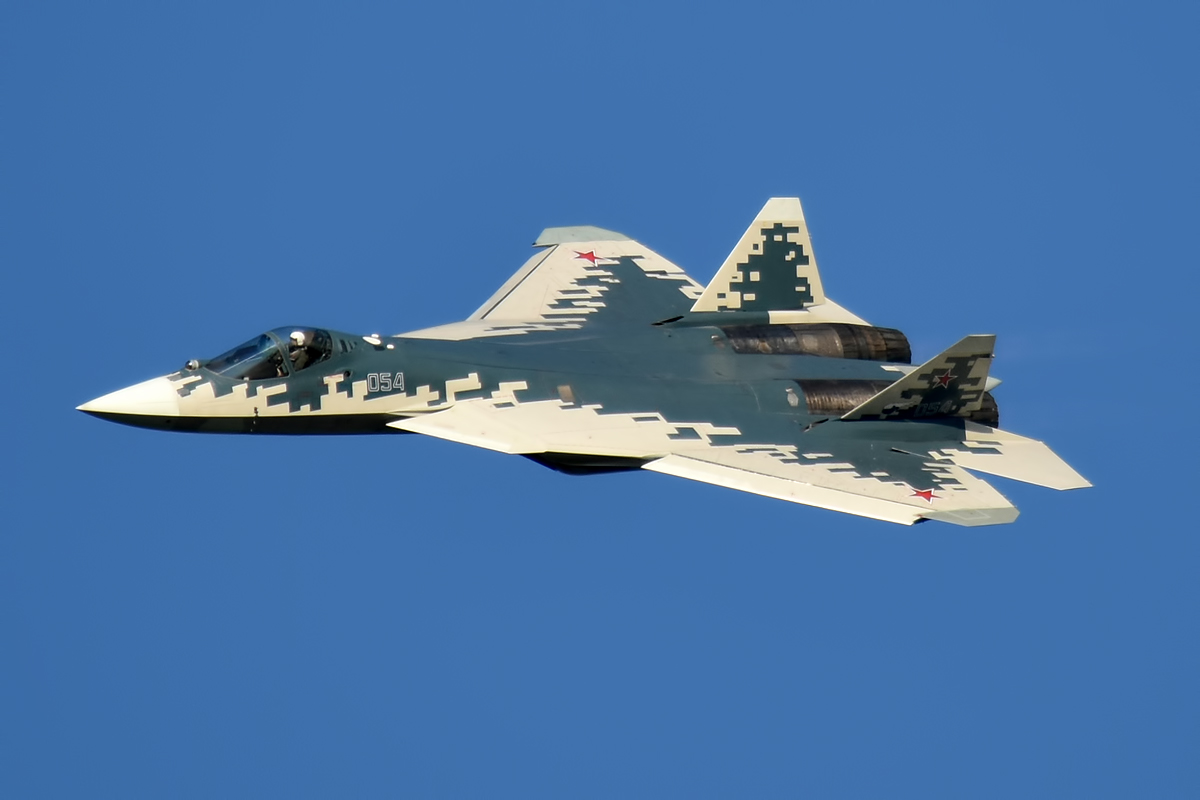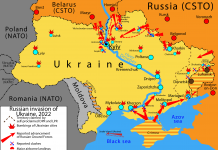
A Russian Su-57 fifth-generation fighter reportedly conducted an unanticipated stop at Iran’s Bandar Abbas airbase, drawing significant attention within military and aviation circles.
Sources, primarily from Iranian social media, suggest that the advanced combat aircraft landed at the 9th Tactical Air Force Base while returning to Russia from Aero India 2025, an international aerospace exhibition held in Bangalore. The reports indicate that the layover was brief, allowing for refueling before the aircraft continued its journey northward. Given the considerable flight distance between India and Russia—exceeding 4,000 kilometers depending on routing—this logistical stop aligns with the operational range limitations of the Su-57.
With an estimated subsonic range of approximately 3,500 kilometers when operating on internal fuel, the Su-57 would reasonably require an intermediary refueling point during such a transit. Bandar Abbas, positioned strategically near the Persian Gulf, serves as a practical stopover, particularly in the context of Moscow and Tehran’s deepening defense relations.
Iranian defense analysts have noted that this marks the first publicly known instance of a Su-57 entering Iranian airspace, diverging from previous Russian aerial transit patterns. Traditionally, Russian military aircraft on extended missions would utilize Syria’s Hmeimim Airbase for refueling and logistical support. However, the deteriorating stability of the Assad regime has likely rendered Hmeimim less viable, necessitating alternative routing options through Iranian territory.
Beyond addressing an operational requirement, this deviation presented Iran with an opportunity for an up-close assessment of Russia’s premier stealth platform. Such exposure could hold relevance amid ongoing negotiations regarding potential arms transfers, including previously reported discussions over Su-35 acquisitions.
Neither Moscow nor Tehran has issued an official statement regarding the stopover, yet the absence of outright denial lends credibility to the claim that the maneuver was logistical in nature rather than a deliberate geopolitical signal. Nevertheless, the presence of an Su-57 on Iranian soil, even briefly, invites scrutiny, particularly against the backdrop of Russia’s active efforts to promote its military aviation exports.
The Su-57’s presence at Aero India 2025 was a key component of Russia’s broader strategy to assert its aerospace capabilities on the international stage. The biennial event, hosted in mid-February at Bangalore’s Yelahanka Air Force Station, served as a platform for global defense manufacturers to showcase their latest advancements. Russia’s United Aircraft Corporation leveraged the opportunity to position the Su-57 as a direct competitor to Western fifth-generation platforms such as the F-35 and F-22.
Aerial demonstrations highlighted the aircraft’s maneuverability, stealth features, and avionics capabilities, reinforcing Moscow’s intent to attract export customers. India, a longstanding Russian defense partner with an extensive history of operating Soviet-era and Russian-built aircraft—including the MiG-29 and Su-30—was a prime target for these efforts. While Indian officials reportedly inspected the aircraft, no formal procurement commitments emerged from the event.
From a technical standpoint, the Su-57 represents Russia’s most advanced attempt at developing a next-generation multirole fighter. First flown in 2010 and designated “Felon” by NATO, the platform integrates stealth technology, supercruise capability, and sensor fusion to enhance its combat effectiveness.
Measuring 20.8 meters in length with a wingspan of 14.1 meters, the aircraft is powered by twin Saturn AL-41F1 engines, each producing 32,500 pounds of thrust with afterburners, enabling speeds exceeding Mach 2. Its airframe incorporates radar-absorbent materials to reduce its radar cross-section, though Western assessments continue to debate the extent of its stealth effectiveness relative to U.S. counterparts.
The aircraft’s avionics suite is anchored by the N036 Byelka radar, an active electronically scanned array (AESA) system providing 360-degree threat detection with a range of up to 400 kilometers. Complementary infrared search-and-track (IRST) and electro-optical targeting systems further enhance its situational awareness and engagement capability. The cockpit is equipped with a wide-angle heads-up display and voice-command functionality, streamlining pilot workload in high-intensity scenarios.
Regarding armament, the Su-57 features a combination of internal weapons bays and external hardpoints, enabling it to carry a diverse array of air-to-air and air-to-ground munitions. These include the R-77M, a beyond-visual-range air-to-air missile with an estimated range of 110 kilometers, and the short-range R-74 for close-quarters engagements. For ground-attack missions, the jet can deploy precision-guided munitions such as the KAB-500S satellite-guided bomb and the Kh-38M modular missile, available in anti-ship, anti-radar, and high-explosive configurations.
While the hypersonic Kh-47M2 Kinzhal missile has been associated with Russian air operations, its integration with the Su-57 remains speculative. The aircraft’s total payload capacity, estimated at 10 tons, underscores its operational versatility across multiple combat scenarios.
The Su-57’s combat record remains limited, with its operational deployment primarily centered around Russia’s military campaign in Ukraine. Moscow first acknowledged its combat use in June 2022, releasing official footage of the aircraft conducting precision strikes against Ukrainian targets. Open-source intelligence has linked the Su-57 to a March 5, 2022, strike on an ammunition depot in Zhytomyr, likely employing Kh-59 cruise missiles. Additional reports indicate sorties over Kharkiv and Dnipro, though its overall combat footprint has been relatively restrained.
Western defense analysts note that Russia has employed the Su-57 in a limited role, leveraging its stand-off weaponry to mitigate exposure to Ukrainian air defenses. This cautious deployment strategy, coupled with low production numbers—fewer than a dozen operational units by 2022—suggests that the Su-57 remains a high-value asset rather than a frontline workhorse.
Despite these constraints, Russia has signaled its intent to accelerate Su-57 production, with state projections targeting 76 units by 2028. Given these plans, the aircraft’s recent refueling stop in Iran may hint at broader operational deployments in the future, particularly as Moscow continues to navigate geopolitical and logistical challenges in sustaining its airpower reach.





